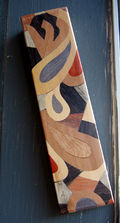Woodworking

Woodworking is the process of building, making or carving something using wood.
Contents |
History

Along with stone, mud, and animal parts, wood was certainly one of the first materials worked by primitive human beings. Microwear analysis of the Mousterian stone tools used by the Neanderthals show that many were used to work wood. The development of civilization was closely tied to the development of increasingly greater degrees of skill in working these materials.

Among early finds of wooden tools are the worked sticks from Kalambo Falls, Clacton-on-Sea and Lehringen. The spears from Schöningen (Germany) provide some of the first examples of wooden hunting gear. Flint tools were used for carving. Since Neolithic times, carved wooden vessels are known, for example, from the Linear Pottery culture wells at Kückhofen and Eythra. Examples of Bronze Age wood-carving include tree trunks worked into coffins from northern Germany and Denmark and wooden folding-chairs. The site of Fellbach-Schmieden in Germany has provided fine examples of wooden animal statues from the Iron Age. Wooden idols from the La Tène period are known from a sanctuary at the source of the Seine in France.
Two ancient civilizations that used woodworking were the Egyptians and the Chinese. Woodworking is depicted in many ancient Egyptian drawings, and a considerable amount of ancient Egyptian furniture (such as stools, chairs, tables, beds, chests) has been preserved in tombs. As well, the inner coffins found in the tombs were also made of wood. The metal used by the Egyptians for woodworking tools was originally copper and eventually, after 2000 BC bronze as ironworking was unknown until much later.[1] Commonly used woodworking tools included axes, adzes, chisels, pull saws, and bow drills. Mortise and tenon joints are attested from the earliest Predynastic period. These joints were strengthened using peg s, dowels and leather or cord lashings. Animal glue came to be used only in the New Kingdom period.[2] Ancient Egyptians invented the art of veneering and used varnishes for finishing, though the composition of these varnishes is unknown. Although different native acacias were used, as was the wood from the local sycamore and tamarisk trees, deforestation in the Nile valley resulted in the need for the importation of wood, notably cedar, but also Aleppo pine, boxwood and oak, starting from the Second Dynasty.[3]
The progenitors of Chinese woodworking are considered to be Lu Ban (魯班) and his wife Lady Yun, from the Spring and Autumn Period. Lu Ban is said to have brought the plane, chalkline, and other tools to China. His teachings are supposedly left behind in the book Lu Ban Jing (魯班經, "Manuscript of Lu Ban"), although it was written some 1500 years after his death. This book is filled largely with descriptions of dimensions for use in building various items such as flower pots, tables, altars, etc., and also contains extensive instructions concerning Feng Shui. It mentions almost nothing of the intricate glueless and nailless joinery for which Chinese furniture was so famous.
Materials
Historically, woodworkers relied upon the woods native to their region, until transportation and trade innovations made more exotic woods available to the craftsman. Woods can be sorted into three basic types: hardwoods typified by tight grain and derived from broadleaf trees, softwoods from coniferous trees, and man-made materials such as plywood and MDF.
Typically furniture such as tables and chairs is made using solid stock, and cabinet/fixture makers employ the use of plywood and other man made panel products.
Notable woodworkers
- Alvar Aalto
- Norm Abram
- Dan Corlis
- John Boson
- Henning Engelsen
- Wharton Esherick
- Tage Frid
- R. Bruce Hoadley
- James Krenov
- Mark Lindquist
- Sal Maccarone
- John Makepeace
- Sam Maloof
- David J. Marks
- George Nakashima
- Jere Osgood
- Alan Peters
- André Jacob Roubo
- Paul Sellers : Teacher and lecturer in the US and UK. Known for his preference for hand tools.
- Evert Sodergren
- Henry O. Studley
- Roy Underhill
See also
|
|
Notes
- ↑ Leospo, Enrichetta (2001), "Woodworking in Ancient Egypt", The Art of Woodworking, Turin: Museo Egizio, p.20
- ↑ Leospo, pp.20-21
- ↑ Leospo, pp. 17-19
References
- Feirer, John L. (1988). Cabinetmaking and Millwork. Mission Hills California: Glencoe Publishing. ISBN 0-02-675950-0.
- Frid, Tage (1979). Tage Frid Teaches Woodworking. Newton, Connecticut: Taunton Press. ISBN 0-918804-03-5.
- Joyce, Edward; revised and expanded by Alan Peters (1987). Encyclopedia of Furniture Making. New York: Sterling Publishing Co.. ISBN 0-8069-6440-5 (ISBN 0-8069-7142-8 Paperback).
- Roubo, André Jacob (1769-1784). The Art of the Joiner. Paris: French Academy of Sciences.
External links
- The Woodworkers Institute
- The Wood Database at Wood Crafts
|
||||||||||||||||||||||
